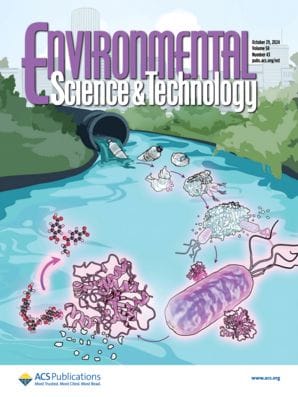Can nature offer us a way out of continuing microplastic pollution? Researchers are investigating microorganisms—and more specifically their enzymes—that can deteriorate and modify plastics.

We all know that plastic pollution is a huge concern, and microplastics—fragments smaller than 5 millimeters—are a substantial environmental problem. This includes fibers that find their way into wastewater from a variety of sources both industrial and domestic. Many of these tiny particles slip through water purification processes and end up in the wider environment. Wastewater effluent contains various types of microplastics, but polyethylene terephthalate (PET) is the most abundant at around 50%.1 This represents a key challenge: if we can’t stop it getting into our wastewater, can we at least stop it moving any further on into natural ecosystems?
One idea is to consider the potential biodeterioration and biodegradation of PET by microorganisms within water treatment facilities. In particular, Comamonadaceae bacteria have been found on microplastics in wastewater effluent and urban rivers. Within this family a genus called Comamonas contains several species that can catabolize a wide spectrum of aromatic compounds, including a monomer derivative of PET.2 But it is not yet known whether wastewater Comamonas species possess enzymes that will facilitate PET depolymerization.
A team from the United States set out to investigate these mechanisms by combining microscopy, spectroscopy, proteomics, protein modeling, and genetic engineering.3 The study, published in Environmental Science & Technology, revealed significant fragmentation of PET pellets, as well as a 3.5-fold increase in the abundance of nanoparticles (<100 nm) during 30-day cultivation of Comamonas testosteroniKF-1 in a wastewater isolate—primarily due to hydrolytic cleavage. Adding acetate, a common wastewater co-substrate, appeared to promote cell growth and PET fragmentation.

Mechanisms of Polyethylene Terephthalate Pellet Fragmentation into Nanoplastics and Assimilable Carbons by Wastewater Comamonas
DOI: 10.1021/acs.est.4c06645
The genome was already known to encode for multiple hydrolases, which could be involved in plastic depolymerization.4 However, of the multiple hydrolases encoded in the bacterial genome, intracellular proteomics detected only one in both acetate-only and PET-only conditions. Mutants lacking this hydrolase gene were incapable of PET oligomer hydrolysis and had a 21% decrease in PET fragmentation, but experiments showed that re-inserting the gene restored both functions. This suggests that the gene is a key PET-degrading hydrolase that could be exploited for plastic bioconversion, with implications for both the fate of microplastics in the environment and future biotechnology applications.
But PET is not the only microplastic pollutant, and degradation rates and bacterial community compositions vary. An earlier paper in Environmental Science & Technology from a team in Finland found poly-l-lactic acid showed no signs of degradation, whereas poly(3-hydroxybutyrate/3-hydroxyvalerate), plasticized starch, and cellulose acetate degraded completely or almost completely during 1-year in situ incubations.5 Over the same time period, bacterial taxa potentially capable of using complex carbon substrates were significantly enriched on these microplastics. In particular, there was an increase in gammaproteobacterial abundance observed in the biodegradation experiments. The results show substantial differences in the persistence and biodegradation rates among bioplastics, highlighting the need for more careful management of microplastics.
References
- Wolff, S. et al. Determination of the Microplastics Emission in the Effluent of a Municipal Waste Water Treatment Plant Using Raman Microspectroscopy. Water Research X 2019, 2, 100014.
- Kincannon, W.M. et al. Biochemical and Structural Characterization of an Aromatic Ring-Hydroxylating Dioxygenase for Terephthalic Acid Catabolism. Proc. Natl. Acad. Sci. U. S. A. 2022, 119 (13), e2121426119.
- Wilkes RA, et al. Mechanisms of Polyethylene Terephthalate Pellet Fragmentation into Nanoplastics and Assimilable Carbons by Wastewater Comamonas. Environ. Sci. Technol. 2024, 58, 43, 19338–19352.
- von Haugwitz, G. et al. Structural Insights into (Tere)phthalate-Ester Hydrolysis by a Carboxylesterase and Its Role in Promoting PET Depolymerization. ACS Catal. 2022, 12, 24, 15259–15270.
- Eronen-Rasimus, E.L. et al. Degradation Rates and Bacterial Community Compositions Vary among Commonly Used Bioplastic Materials in a Brackish Marine Environment. Environ. Sci. Technol. 2022, 56, 22, 15760–15769.
